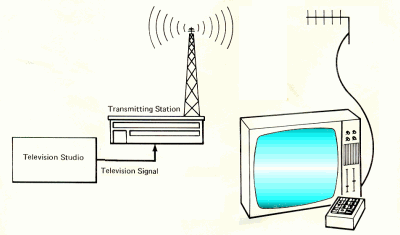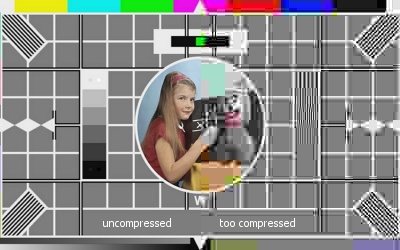Do I need to buy a booster?
 Brian Butterworth published on UK Free TV
Brian Butterworth published on UK Free TV With analogue television, it has often been necessary to buy an amplifier to improve the quality of the television picture, or to supply a steady on several televisions fed from the same aerial.
Many people have asked if it necessary to investing in a signal booster for Freeview.
"Analogue television" means is that the sound and pictures are broadcast using signals that are an "analogue" of the input. The sound and picture are transmitted from the source as electrical signals, then as radio waves and then back to sound and picture again.
In an analogue television camera, the image is scanned 25 times a second from side to side, from top to bottom and back. Where a lot of light is scanned, a high voltage is produced. Where no light is scanned, no voltage is produced. The output voltage is the same ratio to amount of light at scanned.
Leaving aside the technically, this signal is sent to the transmitter. The transmitter emits a radio wave on a known frequency, which is varied by the incoming voltage.

A microphone also converts the sound vibrations it picks up into a voltage, which when sent to the transmitter is added to another radio transmission frequency.
The signals are received by a television aerial pointing at the transmitter and converted back to very weak electrical signals. The sound is amplified and sent to a loudspeaker, and a picture created on the TV screen.
So on an analogue television, if the incoming signal is weak then the picture is dull as the background noise (the snow scene seen when an analogue television is not tuned) makes the picture less watchable.
The best analogue television set equipped with a great TV aerial located near to a high powered transmitter will produce brilliant pictures and clear sound. A poor set with an inadequate aerial or substandard cable will not.
If a weak signal is fed to a booster device, this will make the picture appear better on the television set or sets. It is often worth the investment.
Digital television
In a digital studio, the voltages from the cameras and microphones are not sent directly to the transmitter. It is converted into a stream of numbers inside a computer. The input voltage relates directly to the number in the computer. By sampling the input at a regular frequency, it is therefore possible to both store and transmit the information digitally this is what computers are good at.
It is therefore possible to take these numbers and generate a sound and picture output from them. However, the amount of information generated is over 240Mb/s, 30 times the rate of the fastest broadband connection.
Buy using computational techniques on this information the data can be compressed to as low as 2Mb/s, with as little as 6Mb/s being required for a good quality picture. These data compression techniques are called "lossy" because the reconstructed images are not identical to the originals, but look virtually similar to human eyes.

Digital television uses the same transmission frequencies as analogue uses, known as C21 to C68. The digital data is sent using a system called COFDM (Coded Orthogonal Frequency-Division-Multiplexing) which can carry data at a rate of 18Mb/s or 24Mb/s. Several television channels and some radio stations can be multiplexed together to produce exactly this amount of data.
At the receiver, it must be able to decode every single bit from these transmission multiplexes. A single error is impossible to correct for, so the decoder must have no errors.
Until switchover happens, the Freeview signals are being broadcast at very, very low power levels. However the COFDM system and sensitive digital equipment will, as long as the signal can be found and decoded there will be pixel-perfect reconstruction of the television channel. If the signal is drowned out by interference (especially from analogue transmissions) then no picture or sound will be output.
If the TV aerial installation you have provides you with all the Freeview channels, there is nothing to worry about.
If you are missing some channels because the signal is just too weak the best place to start is by improving the aerial, see Freeview reception - All about aerials. A bigger, higher, better designed aerial will always be the most sensible way to get perfect reception.
If you want to supply a signal to several sets, where the incoming signal is being "split" to serve several Freeview boxes, a masthead amplifier will be effective. This is because the signal is already of good quality and is being repeated for several sets.
However, if you are not getting a good signal from your aerial, a booster by the TV set will probably not help as this will simply boost the background interference as much as the Freeview signal.
In circumstances where an amplifier that has improved a picture on an analogue, it may be unsuitable for Freeview reception. Sometimes they will block one or more multiplex, where disconnecting the amplifier will restore the channels.
9:55 PM
I have an old tv, but a brand new goodmans freeview player. I am using an indoor aerial, which the freeview player does not recommend - but I have no choice, and am getting poor signal. Would an aerial signal booster help? And if so which one would you reccommend? Hope you can help.
Lucy
| link to this comment |
Lucy: No, a booster will not help. You need a rooftop aerial.
| link to this comment |
Alyson: Just try running cable from your existing aerial to the other rooms, you will probably get four of the six multiplexes OK from your existing aerial.
| link to this comment |
7:05 PM
Newcastle Upon Tyne
Hi - My friend is having problems with her Freeview reception at location NE1 5BZ. The problems started yesterday morning May 7 and I've been trying to help her. Freeview box window on the TV was displaying 'no signal' after working fine the previosu evening. We connected the indoor digital aerial directly to the TV and no problem - we were able to pick up analogue channels. We next tried unplugging everything, swapping scart leads around but no joy. My friend decided it must be the freeview box so we bought a new one from maplin yesterday. Fine worked great but no Channel 4 or ITV2. Swapped it for a more expensive model and managed to get all the channels. However today she is getting picture freeze on most channels. Is it the weather? Pontop and Fenham arent reporting any transmitter works so any ideas. She's spent around £90 and is going spare. Help!
Antony
| link to this comment |
Antony's: mapA's Freeview map terrainA's terrain plot wavesA's frequency data A's Freeview Detailed Coverage
1:11 PM
Antony Antoniou: Indoor aerials nearly always give less reliable results. You won't have line-of-sight to the transmitter because it will be blocked by the house walls and by neighbouring buildings. There will be many reflections off other surfaces and even off people moving around in the house. For best results you should always use a rooftop aerial with clear space all around it.
In addition, indoor aerials are usually just too small. For best results, the elements should be about one-half of the wavelength of the transmissions, so they resonate at that frequency. For Pontop Pike, they should be about 17cm long, with the back element - the reflector - being about 20cm. Fenham uses much lower frequencies and really needs larger elements spaced further apart.
That's assuming the design is actually based on engineering and physics, and not just something that looks good. Many indoor aerials, when tested, are found to be worse than a plain dipole - a single rod of the correct length - which is the baseline against which all other aerials are measured.
At that location you should get better results from Pontop Pike than from Fenham. Make sure the aerial is pointing in that direction - south-west - and the elements are horizontal. Try to position the aerial higher up - but not too close to ceilings - and looking through as little brick-work as possible.
It's possible that the box will still try to tune into the weaker signals from Fenham, because they are on lower frequencies. You may have to manually tune to get it to use the frequencies from Pontop Pike. See that transmitter's page for the frequencies to use.
| link to this comment |
12:20 AM
Leeds
Can a masthead amplifier be damaged by leaving it unpowered for any length of time, or by switching it on and off regularly? Does it need time to 'warm up' after being off for a while?
I like to switch off non-essential mains devices when not being used, such as the masthead amplifier when nobody is watching TV overnight. After switching back on, I find that Freeview reception seems to have gotten worse. It could just be a coincidence, but do you experts know any better?
| link to this comment |
Thomas's: mapT's Freeview map terrainT's terrain plot wavesT's frequency data T's Freeview Detailed Coverage
Thomas: It is not normal to unplug the power to a masthead amplifier, given the very, very tiny amount of power they use.
They should be no problem, however, turning it on and off, this should sustain no damaged to the amplifier.
| link to this comment |
9:14 PM
Basingstoke
Hi
I've just moved into a block of flats in Basingstoke, there are a set of sockets on the wall for satellite connections and for standard coax TV's etc. All my equipment worked perfectly well in my old flat, now however my Thompson set top box says no signal on every channel and my TV will only tune into BBC 1 and 2 analogue and even those channels are very bad reception, any ideas?? RG21 7AQ
| link to this comment |
Jerre's: mapJ's Freeview map terrainJ's terrain plot wavesJ's frequency data J's Freeview Detailed Coverage